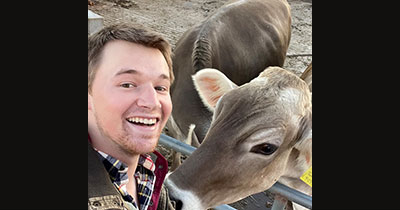Graduate Student Spotlight: Cole Roecker
Graduate Student Spotlight: Cole Roecker

Hello! My name is Cole Roecker and I’m a first-year PhD student in the history department. I’m studying American environmental history under Professor Keith Woodhouse. My first-year research project plunged me into the wild world of nineteenth-century ranching, railroads, and regulation. Tentatively titled “Cattle Control: The American Cattle Industry and the Birth of Federal Regulation, 1865-1890,” my essay investigates the relationship between livestock disease, the U.S. cattle industry, and the beginnings of federal regulation in the 1880s. Two particularly fatal bovine diseases take center stage: contagious bovine pleuropneumonia (“Cattle Lung”) and Texas cattle fever.
I didn’t arrive at Northwestern intending to study agricultural history. In fact, my statement of purpose outlined plans to study the French explorer Jacques Cartier’s arrival to the Gulf of Saint Lawrence in 1534. I changed course completely due to a chance visit to the federal documents collection at the Northwestern Library in September. For no particular reason, I plucked a 1905 United States Department of Agriculture report off the shelf and opened to a bizarre paragraph that described federal agents coating southern cattle in crude oil in the dead of summer. I instantly fell down the all-too-common historical rabbit hole. Why on earth would federal agents slather cattle in oil?
Having grown up in Wisconsin, I should have figured that cows would find me sooner or later.
I went on to discover that the federal government used crude oil as an insecticide to control the cattle ticks responsible for spreading a fatal and costly bovine disease of the past—Texas cattle fever. The story of the effort to suppress Texas cattle fever proved just a chapter in the much larger story about federal attempts to control the proliferation of cattle diseases in the late-nineteenth century. Together with bovine pleuropneumonia, Texas fever threatened to topple the nation’s multibillion-dollar cattle industry. Fearing economic catastrophe, in 1884 the federal government moved to control the spread of disease by creating the first-ever federal regulatory body with significant police powers over private business and the states—the Bureau of Animal Industry (BAI). The BAI, I argue, constitutes the earliest example of significant federal regulation of private industry, predating the more infamous clash between the federal government and railroad monopolies in the late 1880s and 1890s.
The more I dig into the history of cattle disease and federal regulation, the more I feel that I’ve chanced upon an extremely interesting Pandora’s Box. I’ve learned about a colorful cast of characters: cowboys, cattle breeders, and congressmen of the late-nineteenth century whose lives evoke episodes of old Westerns like Gunsmoke or Bonanza. Chiefly, however, my goal is to show that the so-called “Wild West” wasn’t just a world of gunslingers and fifteen-gallon hats; rather, it was intimately tied to and dependent upon politics in Washington, D.C. Likewise, the politics of Washington cannot be understood in isolation from the West. More research suggests plenty of other cattle chronicles waiting to be told: There’s the proposed 250-mile long, 2-mile wide federal “livestock highway” that would have stretched from Texas to Nebraska, and that only narrowly missed ratification in the House in 1886. And the fact that in 1890, the BAI proved that Texas cattle fever was carried and spread by ticks, thus isolating the first vector-borne disease in history. That discovery revolutionized medical understandings of other vector diseases like malaria, yellow fever, and typhus.
While I have yet to decide if these livestock stories will become important to my dissertation, they’ve been a welcome, if unexpected, turn in my first year in Northwestern’s History Department. At the very least, my research has allowed me to appreciate the importance of agricultural history, a subfield that in my view does not receive enough attention from U.S. historians. I look forward to my first opportunity to present my work, which I’ll do at the Environmental Humanities Congress, hosted by Indiana University in June. Finally, I’d like to thank our department’s wonderful faculty, who have generously helped “steer” my scholarship in the right direction as I begin my journey as a historian.
